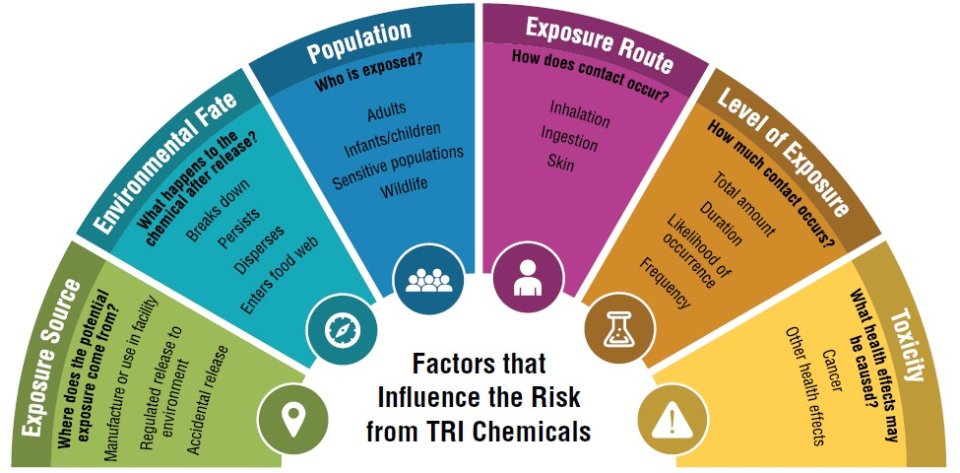Potential Risks from TRI Chemicals
Chemicals that are included on the TRI chemical list can cause harm to humans, organisms, and ecosystems. Risk is the likelihood that a TRI chemical released into the environment will cause harm to humans or the environment. Many factors determine the risks that may come from exposure to toxic chemicals. The figure below lists factors that influence risks posed by TRI chemicals.
The quantities of TRI chemicals released into the environment do not indicate potential risks to health because these quantities alone do not consider the extent of exposure or the toxicity of the chemicals. The chemical release data collected through TRI reporting can be used as a starting point—along with other resources such as EPA's Risk-Screening Environmental Indicators (RSEI) model—to help evaluate potential harm and risks to health from TRI chemical exposure.
Overview of Factors that Influence Risk

The hazard of a chemical is its inherent ability to cause an adverse effect on health (e.g., cancer, birth defects).
Exposure is how a person comes into contact with a chemical (e.g., inhalation, ingestion) and can be described in terms of its magnitude (how much), frequency (how often), and duration (how long).
The likelihood that a toxic chemical will cause an adverse health effect is often referred to as risk. Risk is a function of hazard and exposure.
EPA developed the Risk-Screening Environmental Indicators (RSEI) model to help identify geographic areas, industry sectors, and chemical releases that may be associated with significant human health risks and to examine how these potential risks change over time. RSEI incorporates information from TRI on the amount of chemicals released along with factors such as how chemicals change and where they go as they move through the environment, each chemical’s relative toxicity, and the potential for human exposure.
People are most likely to be exposed to TRI chemicals through the air or water, so RSEI focuses on releases to air and water, including releases to air from waste incinerators and releases to water following transfers to publicly owned treatment works (POTWs). Using the release quantities reported to TRI, the RSEI model produces two primary results—hazard-based values (RSEI Hazard) and risk-related scores (RSEI Score)—that enable screening-level comparisons of relative potential harm and potential risks to human health from TRI chemicals.
- RSEI Hazard consists of the pounds of a chemical released or transferred multiplied by the chemical's toxicity weight.
- A RSEI Score is a calculated estimate of relative potential human health risk. It is a unitless value that accounts for the amount of a chemical released to air or water, what happens to the chemical in the environment, the size and location(s) of potentially exposed populations, and the chemical’s relative toxicity.
Both RSEI Hazard and RSEI Score provide greater insight on potential health impacts than TRI release quantities alone. However, RSEI Hazard or RSEI Score values do not provide actual levels of harm or risks to human health from TRI chemicals. Rather, these screening-level values are used for relative comparisons, such as the analysis of trends over time or comparison of sectors. Studies and analyses that use RSEI information can help establish priorities for further investigation and to look at changes in potential human health impacts over time. More information on RSEI and its applications is available at EPA’s RSEI website.
This page was published in March 2024 and uses the 2022 TRI National Analysis dataset made public in TRI Explorer in October 2023.
